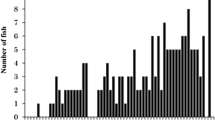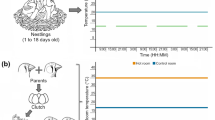Abstract
The effect of an enhanced (5%) sub-lethal UVA irradiation on the total metabolism of a sub- tropical convict cichlid (Cichlasoma nigrofasciatum) is described. The specific oxygen consumption (vo2) of related but differently treated populations was determined from 23 °C to 35 °C, to detect their tolerance limits toward environmental temperature. The experiments cover two generations (G1 and G2) of inbred derived populations. The fish were measured at different stages of development covering the period before and after maturation. The fish were grown at and adapted to 27–29 °C. The results showed that the population which was grown under an enhanced UVA irradiation since hatching (G2-UVA) had developed a general metabolic depression (MD) at all ranges of experimental temperature. The MD was especially expressed after the fish reached maturation. No MD was shown for the non-irradiated control populations (G2-control and G1-control) nor for the mature fish of G1-UVA. The G1-UVA population was grown under an enhanced UVA irradiation from 4 months of age. The vo2 increased with increasing temperature, reaching a maximum at 31–33 °C for the G1- and G2-control populations. For the G1-UVA, a small peak of vo2 was obtained at 29 °C reaching its maximum level at 33 °C. For the G2-UVA population, a maximum vo2 was reached at 33 °C for the young and mature fish and at 29 °C during the maturation period. It can be concluded that the accumulation of UVA irradiation from early life was responsible for the MD in this fish. A wider temperature tolerance observed in the G2-UVA population might possibly be due to a reduction of total metabolic activity. The mechanisms underlying the MD observed in this fish are not yet known, but natural selection and adaptation processes might be involved.
Similar content being viewed by others
References
Adams, N.L. and Shick, J.M. 1996. Mycosporine-like amino acids provide protection against ultraviolet radiation in eggs of the green sea urchins Stronglyocentrotus droebachiensis. Photochemistry and Photobiology 64, 149–158.
Ahmed, F.E. 1993. Different rates of ultraviolet-induced DNA damage in the epidermis and dermis of a platyfish model for carcinogenesis. Radiation and Environmental Biophysics 32, 259–270.
Berghan, R., Bullock, A.M. and Karakiri, M. 1993. Effects of solar radiation on the population dynamics of juvenile flatfish in the shallows of the Wadden Sea. Journal of Fish Biology 42, 329–345.
Cullen, J.J., Neale, P.J. and Lesser, M.P. 1992. Biological weighting function for the inhibition of phytoplankton photosynthesis by ultraviolet radiation. Science 258, 646–650.
Dalla Via, J., van den Thillart, G. and Cattani, O. 1993. Intermediary metabolism and critical levels of hypoxia in the Adriatic sole Solea solea. Biologia Marina, suplemento al Notizario S.I.B.M. 1, 109–113.
Damkaer, D.M. and Dey, D.B. 1983. UV damage and photoreactivation potentials of larval shrimp, Pandalus platyceros, and adult euphausiids, Thysanoessa raschii. Oecologia (Berlin) 60, 169–175.
Dey, D.B., Damkaer, D.M. and Herron, G.A. 1988. UV-B dose/dose-rate responses of seasonally abundant copepods of Puget Sound. Oecologia 76, 321–329.
Fidhiany, L. and Winckler, K. 1994. Pola dan variasi pertumbuhan ikan hias, Cichlasoma nigrofasciatum. Jurnal Biologi Indonesia I, 41–50.
Fidhiany, L. and Winckler, K. 1995. Specific oxygen consumption in two life stages of the cichlid fish Cichlasoma nigrofasciatum. Thermochimica Acta 251, 283–291.
Fidhiany, L. and Winckler, K. 1998. Influence of body mass, age and maturation on specific oxygen consumption in a freshwater cichlid fish, Cichlasoma nigrofasciatum (Günther, 1869). Comparative Biochemistry and Physiology 119A, 613–619.
Frederick, J. 1995. Ultraviolet climatology, Solar ultraviolet radiation and the risk of infectious disease: summary of a workshop. Photochemistry and Photobiology 61, 223–247.
Häder, D.P. and Worrest, R.C. 1991. Effect of enhanced solar ultraviolet radiation on aquatic ecosystems. Photochemistry and Photobiology 53, 717–725.
Holm-Hansen, O., Helbling, E.W. and Lubin, D. 1993a. Ultraviolet radiation in Antarctica: Inhibition of primary production. Photochemistry and Photobiology 58, 567–570.
Holm-Hansen, O., Lubin, D. and Helbling, E.W. 1993b. Ultraviolet radiation and its effects on organisms in aquatic environments. In: Environmental UV Photobiology (eds. A.R. Young, J. Moan, L.O. Björn and W. Nultsch), Plenum Press; New York, USA, pp. 379–418.
Hunter, J.R., Kaupp, S.E. and Taylor, J.H. 1981. Effects of solar and artificial ultraviolet-B radiation on larval northern anchovy, Engraulis mordax. Photochemistry and Photobiology 34, 477–486.
Hunter, J.R., Taylor, J.H. and Moser, H.G. 1979. Effect of ultraviolet irradiation on eggs and larvae of the Northern anchovy, Engraulis mordax, and the pacific mackerel, Scomber japonicus, during the embryonic stage. Photochemistry and Photobiology 29, 325–338.
Jeffrey, W.H. 1996. Ambient solar radiation-induced photodamage in marine bacterioplankton. Photochemistry and Photobiology 64, 419–427.
Karanas, J.J., Worrest, R.C. and Van Dyke, H. 1981. Impact of UV-B radiation on the fecundity of the copepod Acartia clausii. Marine Biology 65, 125–133.
Karentz, D., Bothwell, M.L., Coffin, R.S., Hanson, A., Herndl, G.J., Kilham, S.S., Lesser, M.P., Lindell, Moeller, R.L., Morris, D.P., Neale, P.J., Sanders, R.W., Weiler, C.S. and Wetzel, R.G. 1994. Impact of UV-B radiation on pelagic freshwater ecosystems: Report of working group on bacteria and phytoplankton, Archiv für Hydrobiologie; Beiheft: Ergebnisse der Limnologie 43, 31–69.
Karentz, D., McEuen, E.S., Land, M.C. and Dunlap, W.C. 1991. Survey of mycosporine-like amino acid compounds in Antarctic marine organisms: potential protection from ultraviolet exposure. Marine Biology 108, 157–166.
Kaupp, S.E. and Hunter, J.R. 1981. Photorepair in larval anchovy, Engraulis mordax. Photochemistry and Photobiology 33, 253–256.
Kirk, J.T.O. 1994. Optics of UV-B radiation in natural waters. Archiv für Hydrobiologie; Beiheft: Ergebnisse der Limnologie 43, 1–16.
Little, E.E. and Fabacher, D.L. 1994. Comparative sensitivity of rainbow trout and two threatened salmonids, Apache trout and Lahontan cutthroat trout, to ultraviolet-B radiation. Archiv für Hydrobiologie; Beiheft: Ergebnisse der Limnologie 43, 217–226.
Schmidt-Nielsen, K. 1990. Animal Physiology: Adaptation and Environment, pp. 602. Cambridge University Press; NY, USA.
Setlow, R.B., Woodhead, A.D. and Grist, E. 1993a. Animal model for ultraviolet radiation-induced melanoma: platyfish-swordtail hybrid. Proceedings National Academy of Science USA 86, 8922–8926.
Setlow, R.B., Grist, E., Thomson, K. and Woodhead, A.D. 1993b. Wavelengths effective in induction of malignant melanoma. Proceedings National Academy of Science USA 90, 6666–6670.
Shick, J.M., Lesser, M.P. and Stochaj, W.R. 1991. Ultraviolet radiation and photooxydative stress in zooxanthellate Anthozoa: the sea anemone Phyllodiscus semoni and the octocoral Clavularia sp. Symbiosis 10, 145–173.
Shick, J.M., Lesser, M.P., Dunlap, W.C., Stochaj, W.R., Chalker, B.E. and Wu Won, J. 1995. Depth-dependent responses to solar ultraviolet radiation and oxidative stress in the zooxanthellate coral Acropor microphthalma. Marine Biology 122, 41–51.
Smith, R.C. 1989. Ozone, middle ultraviolet radiation and the aquatic environment. Photochemistry and Photobiology 50, 459–468.
Smith, R.C. and Baker, K.S. 1979. Penetration of UV-B and biologically effective dose-rates in natural waters. Photochemistry and Photobiology 29, 311–323.
Smith, R.C. and Baker, K.S. 1989. Stratospheric ozone, middle ultraviolet radiation and phytoplankton productivity. Oceanography (November), 4–10.
Smith, R.C., Prézelin, B.B., Baker, K.S., Bigidare, R.R., Boucher, N.P., Coley, T., Karentz, D., MacIntyre, S., Matlick, H.A., Menzies, D., Ondrusek, M., Wan, Z. and Waters, K.J. 1992. Ozone depletion: ultraviolet radiation and phytoplankton biology in Antarctic waters. Science 255, 952–959.
Stangl, P., and Wegener, G. 1996. Calorimetric and biochemical studies on the effects of environmental hypoxia and chemicals on freshwater fish. Thermochimica Acta 271, 101–113.
Stickle, W.B., Kapper, M.A., Lin, L.L., Gnaiger, E. and Wang, S.Y. 1989. Metabolic adaptations of several species of crustaceans and molluscs to hypoxia: tolerance and microcalorimetric studies. Biological Bulletin 177, 303–312.
Van Ginneken, V.J.T. 1996. Influence of Hypoxia and Acidification on the Energy Metabolism of Fish: an in vivo 31P-NMR and Calorimetric Study, PhD Thesis, pp. 336. University of Leiden; Leiden, The Netherlands.
Van Ginneken, V.J.T., Addink, A.D.F. and van den Thillart, G.E.E.J.M. 1996. Direct calorimetry of aquatic animals: effects of the combination of acidification and hypoxia on the metabolic rate of fish. Thermochimica Acta 276, 7–15.
Van den Thillart, G., Dalla Via, J., Vitali, G. and Cortesi, P. 1994. Influence of long-term hypoxia exposure on the energy metabolism of Solea solea. I. Critical O2 levels for aerobotic and anaerobic metabolism. Marine Ecology Progress Series 104, 109–117.
Vosjan, J.H. and Pauptit, E. 1992. Penetration of photosynthetically available light (PAR), UV-A and UV-B in Admirably Bay, King George Island, Antarctica. Circumpolar Journal 1–2, 50–58.
Winckler, K. and Fidhiany, L. 1995. A portable, battery powered unit for oximetry on small aquatic animals. Thermochimica Acta 251, 303–306.
Winckler, K. and Fidhiany, L. 1996a. Significant influence of UV-A on the general metabolism in the growing Cichlid fish, Cichlasoma nigrofasciatum. Journal of Photochemistry and Photobiology B: Biology, 33, 131–135.
Winckler, K. and Fidhiany, L. 1996b. Combined effects of constant sublethal UVA irradiation and elevated temperature on the survival and general metabolism of the convict-cichlid fish, Cichlasoma nigrofasciatum. Photochemistry and Photobiology 63, 487–491.
Winckler, K. and Fidhiany, K. 1998. Potential influence of increased sub-lethal UV-A irradiation on aquatic food production (Aquaculture). Zeitschrift für Ernährungswissenschaft 37:Supplement 1, 80–84.
Zigman, S. and Rafferty, N.S. 1994. Effects of near irradiation and antioxidants on the response of dogfish (Mustelus canis) lens to elevated H2O2. Comparative Biochemistry and Physiology 109A, 463–467.
Author information
Authors and Affiliations
Rights and permissions
About this article
Cite this article
Winckler, K., Fidhiany, L. Temperature Tolerance and Metabolic Depression of a Convict Child Under the Influence of Enhanced Ultraviolet-A (320–400 nm) Irradiation. Aquaculture International 7, 13–27 (1999). https://doi.org/10.1023/A:1009236618927
Issue Date:
DOI: https://doi.org/10.1023/A:1009236618927




